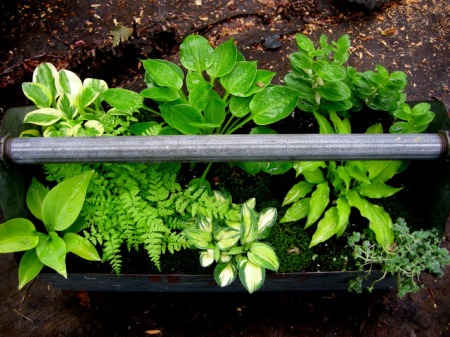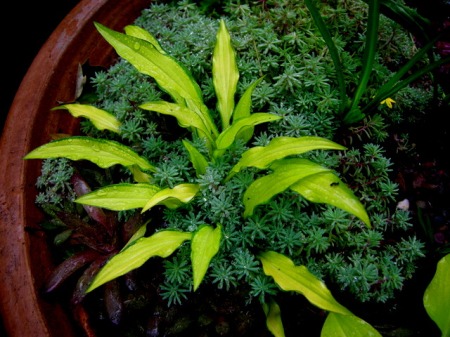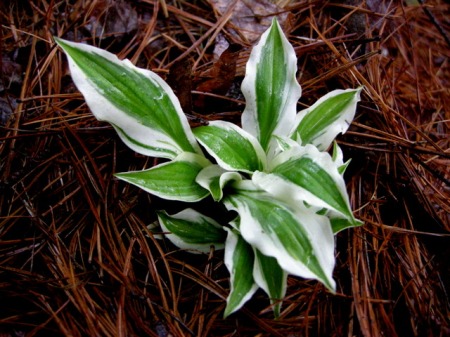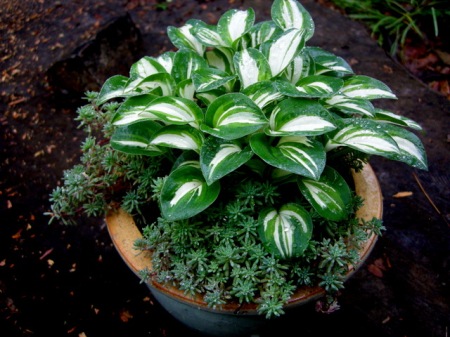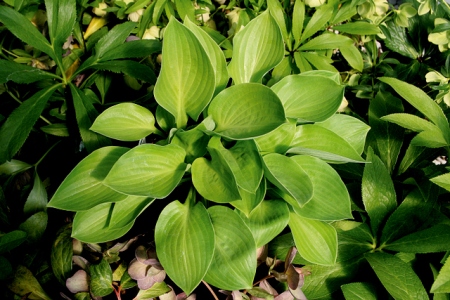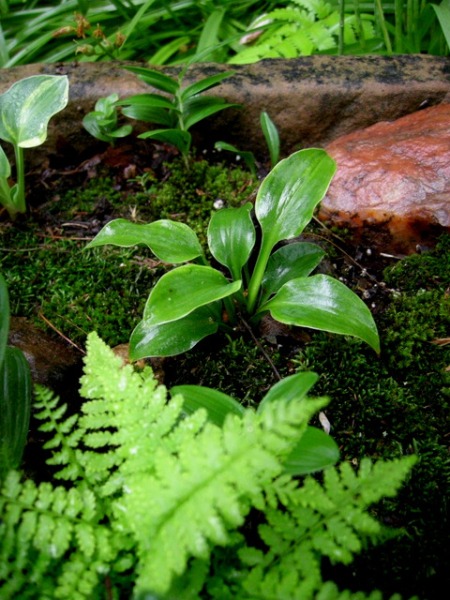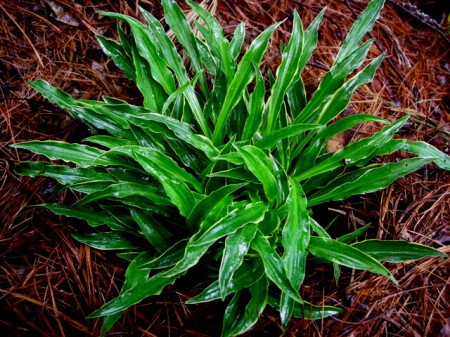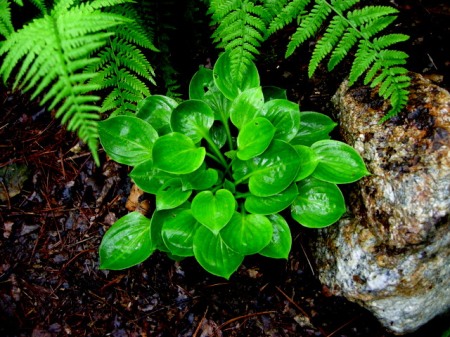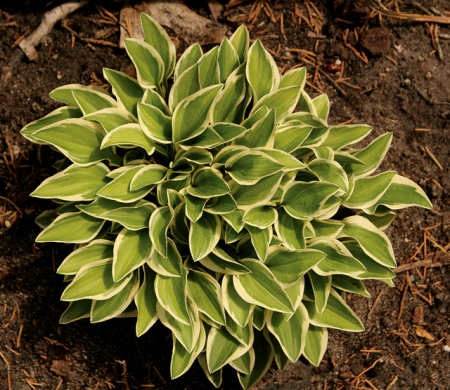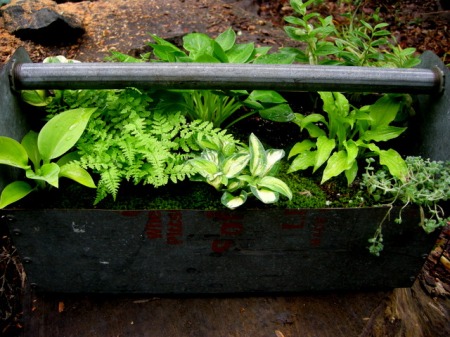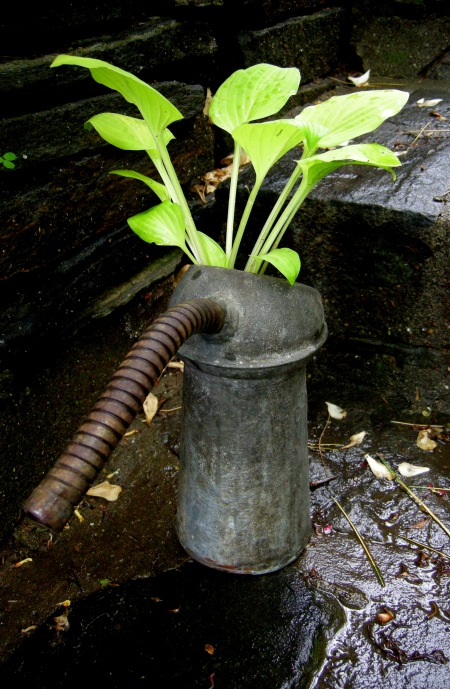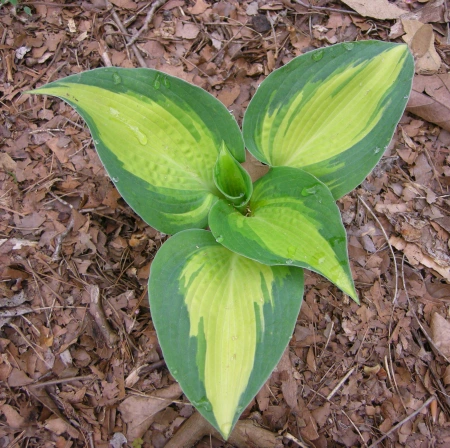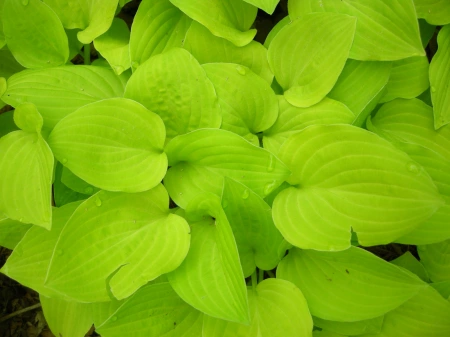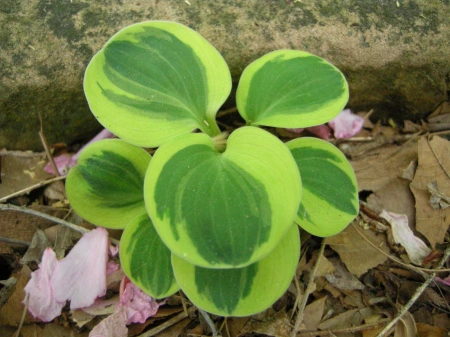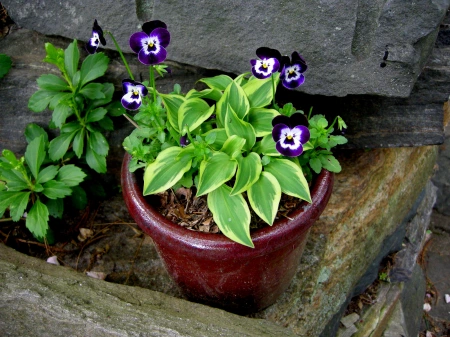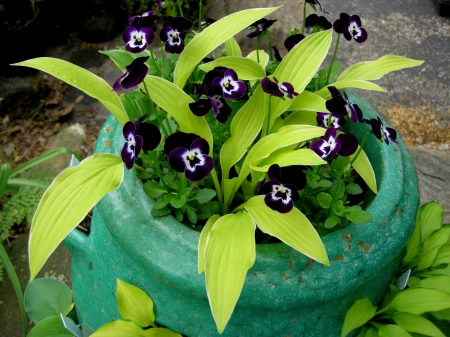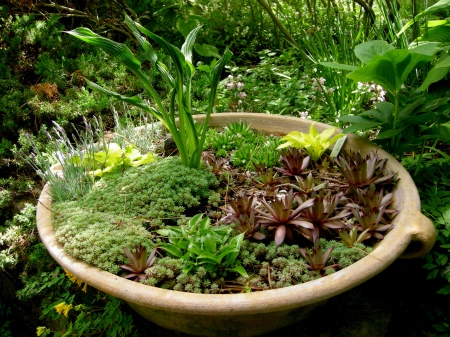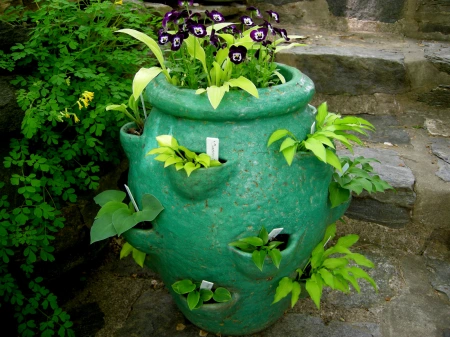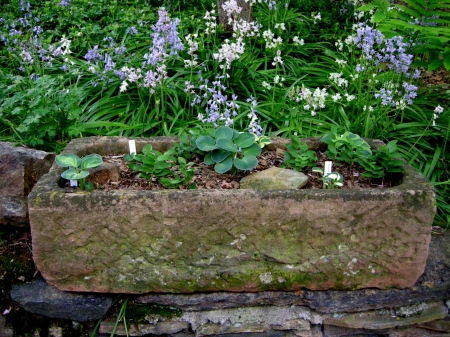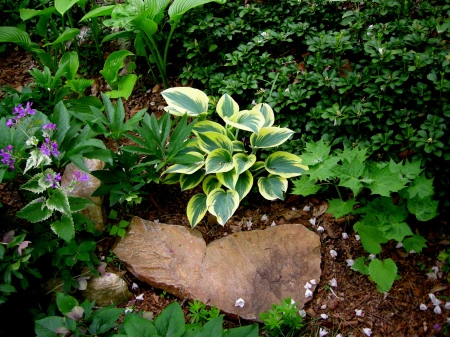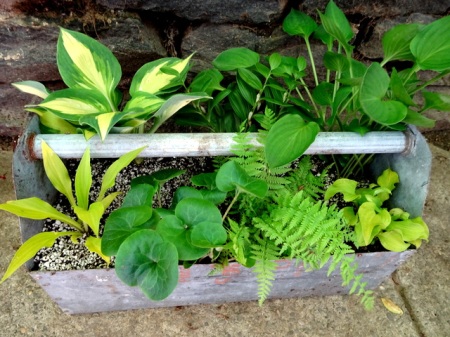 You can use all sorts of fun containers to house your mini hostas. Here ‘Lakeside Cupcake’ and ‘Teaspoon’ (back row) and ‘Sun Mouse’ and ‘Munchkin Fire’ (front row) join mini hosta companion plants dwarf Solomon’s seal, European ginger, and dwarf lady fern in an old toolbox.
You can use all sorts of fun containers to house your mini hostas. Here ‘Lakeside Cupcake’ and ‘Teaspoon’ (back row) and ‘Sun Mouse’ and ‘Munchkin Fire’ (front row) join mini hosta companion plants dwarf Solomon’s seal, European ginger, and dwarf lady fern in an old toolbox.
In May 2011, I wrote my fourth most popular post called Miniature (& Small) Hostas. In it I introduced a number of mini hostas and showed how to use them in the ground and in containers. To read it, click here. In this post, I continue the container theme with some new pots and some new plants in the old pots.
Nursery News: Carolyn’s Shade Gardens is a retail nursery located in Bryn Mawr, PA, specializing in showy, colorful, and unusual plants for shade. The only plants that we ship are snowdrops and miniature hostas. For catalogues and announcements of events, please send your full name, location, and phone number (for back up use only) to carolyn@carolynsshadegardens.com. Click here to get to the home page of our website for catalogues and information about our nursery and to subscribe to our blog.
.
 ‘Twist of Lime’ in a flea market metal milk pitcher.
‘Twist of Lime’ in a flea market metal milk pitcher.
Whether you use a smaller container with a single plant like ‘Twist of Lime’ above or a collection of plants like those featured in the toolbox at the top, there are some important rules to follow. First you must provide adequate drainage. We drill holes in the bottom of our containers and then cover them with pieces of broken terra cotta pots so they don’t get clogged. A layer of broken terra cotta in the bottom is even better.
.
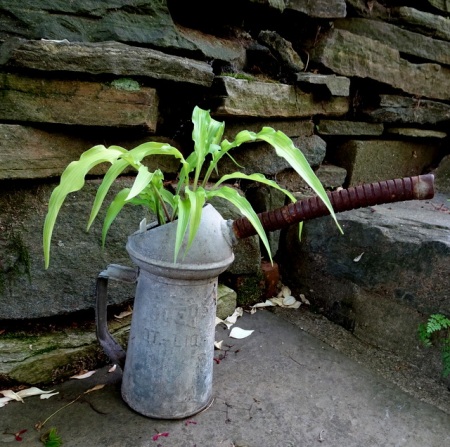 ‘Curly Fries’ continues to live in its re-purposed oil can. It would be bigger and fuller in the ground, but I think it is perfect for this container.
‘Curly Fries’ continues to live in its re-purposed oil can. It would be bigger and fuller in the ground, but I think it is perfect for this container.
Second, if you intend to leave the containers outside for the winter, which is what I do, they must be made of a material that can withstand freezing like stone, metal, concrete, plastic, or high quality glazed ceramic. The plants in the container must also be able to withstand freezing, which hostas and all the companion plants I use are able to do. I store the large containers in place and move the small ones to a protected area and cover them with pine needles.
.
 Two small hostas with contrasting habits make good container companions, here ‘Stiletto’ and ‘Blue Mouse Ears’.
Two small hostas with contrasting habits make good container companions, here ‘Stiletto’ and ‘Blue Mouse Ears’.
.
 Dwarf Solomon’s seal thrives in containers with hostas, filling in nicely. This container has been going strong for six years.
Dwarf Solomon’s seal thrives in containers with hostas, filling in nicely. This container has been going strong for six years.
.
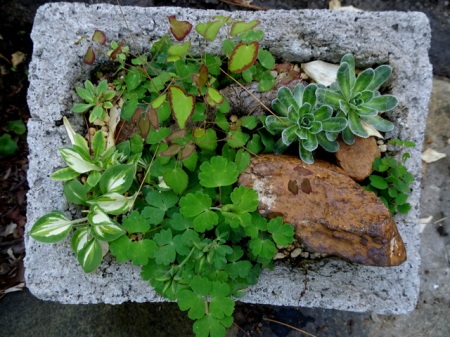 A small trough with a selection of rock garden plants and featuring ‘Pandora’s Box’ hosta (lower left corner) wintered over perfectly on the wall by my front steps.
A small trough with a selection of rock garden plants and featuring ‘Pandora’s Box’ hosta (lower left corner) wintered over perfectly on the wall by my front steps.
Third, the container must be filled with a potting medium that drains well. Thanks to Janet Novak (who created this container) of the Delaware Valley Chapter of the North American Rock Garden Society (DVC-NARGS), I use a mix of one third ProMix, one third vermiculite, and one third small gravel like coarse builders sand or turkey grit. The DVC-NARGS is a great organization with wonderful speakers and events. If you are local you should consider joining, click here.
Those are the basics: now it is up to you to fill the pots. Here are some ideas from my containers:
.
 A close up view of my toolbox, showing the contrasting textures, colors, and habits of the hostas, ginger, Solomon’s seal, and fern.
A close up view of my toolbox, showing the contrasting textures, colors, and habits of the hostas, ginger, Solomon’s seal, and fern.
.
 This is a view of the top of my glazed strawberry pot filled with 17 different mini hostas.
This is a view of the top of my glazed strawberry pot filled with 17 different mini hostas.
.
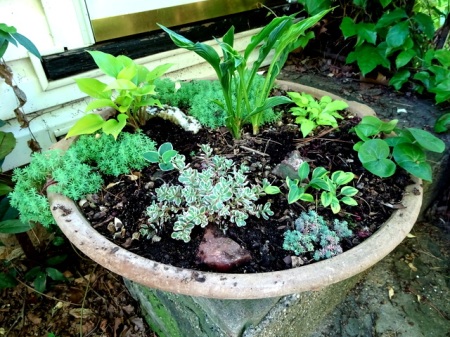 I have had this dish garden in full shade along my front steps for years. It features the bright gold of ‘Appletini’ and ‘Cracker Crumbs’ mini hostas, among others, and ‘Purple Form’ and ‘Tricolor’ sedum along with European ginger, which adds great shiny, round texture.
I have had this dish garden in full shade along my front steps for years. It features the bright gold of ‘Appletini’ and ‘Cracker Crumbs’ mini hostas, among others, and ‘Purple Form’ and ‘Tricolor’ sedum along with European ginger, which adds great shiny, round texture.
.
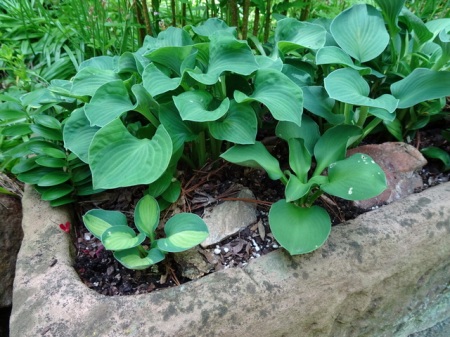 This antique stone trough filled with Mouse Ears hostas, my personal favorites, has been going for years too. This end holds ‘Holy Mouse Ears’, ‘Green Mouse Ears’, and ‘Blue Mouse Ears’, among others.
This antique stone trough filled with Mouse Ears hostas, my personal favorites, has been going for years too. This end holds ‘Holy Mouse Ears’, ‘Green Mouse Ears’, and ‘Blue Mouse Ears’, among others.
.
 A view of the other end of the Mouse Ears trough, featuring clockwise from upper left: dwarf Solomon’s seal, ‘Blue Mouse Ears’, dwarf lady fern, ‘Sunny Mouse Ears’, ‘Mighty Mouse’, ‘Voodoo’ purple sedum, and ‘Frosted Mouse Ears’.
A view of the other end of the Mouse Ears trough, featuring clockwise from upper left: dwarf Solomon’s seal, ‘Blue Mouse Ears’, dwarf lady fern, ‘Sunny Mouse Ears’, ‘Mighty Mouse’, ‘Voodoo’ purple sedum, and ‘Frosted Mouse Ears’.
.
 There will be hand-carved, antique, solid stone troughs for sale on Saturday at the open house for you to use to create you own containers filled with a colorful collection of minis and companions. Four are available, first come, first served!
There will be hand-carved, antique, solid stone troughs for sale on Saturday at the open house for you to use to create you own containers filled with a colorful collection of minis and companions. Four are available, first come, first served!
I hope you can stop by on Saturday between 10 am and 3 pm and see all my mini hostas containers in my garden. They are a lot of fun!
Carolyn
.
Nursery Happenings: You can sign up to receive catalogues and emails about nursery events by sending your full name and phone number to carolynsshadegardens@verizon.net. Subscribing to my blog does not sign you up to receive this information. Please indicate if you will be shopping at the nursery or are mail order only.
Carolyn’s Shade Gardens is a local retail nursery in Bryn Mawr, Pennsylvania, U.S., zone 6b/7a. The only plants that we mail order are snowdrops and miniature hostas and only within the US.
Facebook: Carolyn’s Shade Gardens has a Facebook Page where I post single photos, garden tips, and other information that doesn’t fit into a blog post. You can look at my Facebook page here or click the Like button on my right sidebar here.
Notes: Every word that appears in orange on my blog is a link that you can click for more information. If you want to return to my blog’s homepage to access the sidebar information (catalogues, previous articles, etc.) or to subscribe to my blog, just click here.
